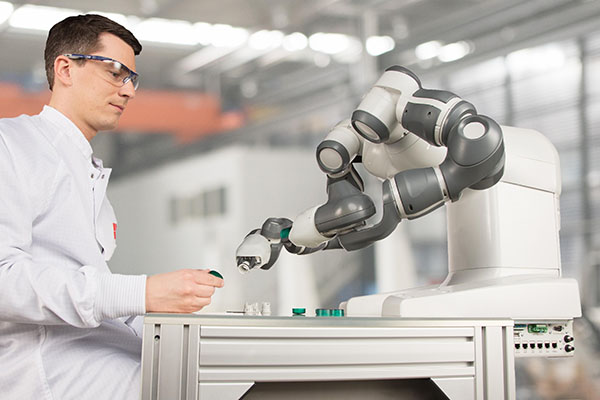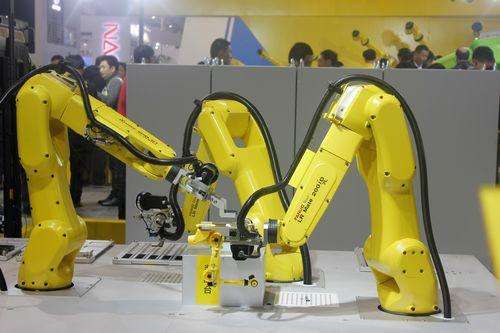Five trends of co-robot in the future
Date:2019-11-08
According to the data of the world robot Federation, the proportion of robots in the world is booming, accounting for more than 50% of the total number of robots. It is predicted that the annual sales volume of global industrial robots will increase to US $23.18 billion in 2020, higher than US $16.82 billion in 2017.
In the future, industrial robots will develop towards the following five trends.
1. Human computer cooperation
Man machine cooperation is an important robot trend, and it is also an increasing driving force. Cobots, which plan to interact with human beings in the workplace, are finding their place in a wide range of jobs.

In an environment where people need to work closely with robots in a more fragmented and intermittent way, safe coexistence becomes more and more important, such as bringing different materials to robots, replacing programs and checking new jobs.
Collaboration on the development of production flexibility to high mix of habits, small batch production is essential. People can add their talents together to adapt and improvise, while robots add tireless endurance to repetitive missions.
2. Artificial intelligence
Artificial intelligence and machine learning will also have a serious impact on the next generation of industrial robots. This will help robots become more autonomous and work hand in hand with their partners, according to the robotics Association for advancement automation.
One trend I'm close to focusing on in 2019 is the integration of AI, robot and machine vision. This convergence of relatively different technologies pioneered new opportunities that had never been used in the early years. The grassroots companies that do this include plus one robotics and righthand robotics.
3. New industrial users
With other jobs accepting the power and mobility that industrial robots can provide, reducing dependence on car jobs is another key trend. With the rapid selection of robots for other tasks, this situation has begun to change in recent years.

Traditionally, sedan operations account for more than 60% of North American shopping malls, but by September 2018, the number dropped to 52%, and non sedan orders reached 48% - creating new records for non sedan operations including life sciences, food and consumer goods, plastics and rubber, and electronic products. We believe that as robots become more flexible, safer, and have a wide range of shapes, they will become more and more attractive to new users of various jobs.
4. Digitalization
Digitalization is also having an impact. As a part of industry 4.0, connected industrial robots occupy a place in the digital production ecosystem.
Digitalization can complete greater collaboration in the whole value chain - horizontal collaboration among suppliers, manufacturers and distributors, or vertical collaboration within the factory, such as collaboration between e-commerce front-end and CRM system, business ERP system, production scheme and logistics automation system. These two types of collaboration can create better customer experience, parallel production power and engineering power, so as to switch between products or launch new products faster.
5. Smaller and lighter robots
Yang Luo, chief executive of Siasun, a giant robot in China, said that promoting simplification, together with smaller and lighter planning, also opened up new opportunities for industrial robots.
As more top technologies are added to industrial robots, industrial robots become smaller, lighter and more flexible, such as virtual reality and artificial intelligence.
In the future, industrial robots will develop towards the following five trends.
1. Human computer cooperation
Man machine cooperation is an important robot trend, and it is also an increasing driving force. Cobots, which plan to interact with human beings in the workplace, are finding their place in a wide range of jobs.

In an environment where people need to work closely with robots in a more fragmented and intermittent way, safe coexistence becomes more and more important, such as bringing different materials to robots, replacing programs and checking new jobs.
Collaboration on the development of production flexibility to high mix of habits, small batch production is essential. People can add their talents together to adapt and improvise, while robots add tireless endurance to repetitive missions.
2. Artificial intelligence
Artificial intelligence and machine learning will also have a serious impact on the next generation of industrial robots. This will help robots become more autonomous and work hand in hand with their partners, according to the robotics Association for advancement automation.
One trend I'm close to focusing on in 2019 is the integration of AI, robot and machine vision. This convergence of relatively different technologies pioneered new opportunities that had never been used in the early years. The grassroots companies that do this include plus one robotics and righthand robotics.
3. New industrial users
With other jobs accepting the power and mobility that industrial robots can provide, reducing dependence on car jobs is another key trend. With the rapid selection of robots for other tasks, this situation has begun to change in recent years.

Traditionally, sedan operations account for more than 60% of North American shopping malls, but by September 2018, the number dropped to 52%, and non sedan orders reached 48% - creating new records for non sedan operations including life sciences, food and consumer goods, plastics and rubber, and electronic products. We believe that as robots become more flexible, safer, and have a wide range of shapes, they will become more and more attractive to new users of various jobs.
4. Digitalization
Digitalization is also having an impact. As a part of industry 4.0, connected industrial robots occupy a place in the digital production ecosystem.
Digitalization can complete greater collaboration in the whole value chain - horizontal collaboration among suppliers, manufacturers and distributors, or vertical collaboration within the factory, such as collaboration between e-commerce front-end and CRM system, business ERP system, production scheme and logistics automation system. These two types of collaboration can create better customer experience, parallel production power and engineering power, so as to switch between products or launch new products faster.
5. Smaller and lighter robots
Yang Luo, chief executive of Siasun, a giant robot in China, said that promoting simplification, together with smaller and lighter planning, also opened up new opportunities for industrial robots.
As more top technologies are added to industrial robots, industrial robots become smaller, lighter and more flexible, such as virtual reality and artificial intelligence.
Previous Article: What robots can do in factories
Next Article: The principle of the reducer, the core part of the robot, is open. Why can’t we compete with Japan’s?